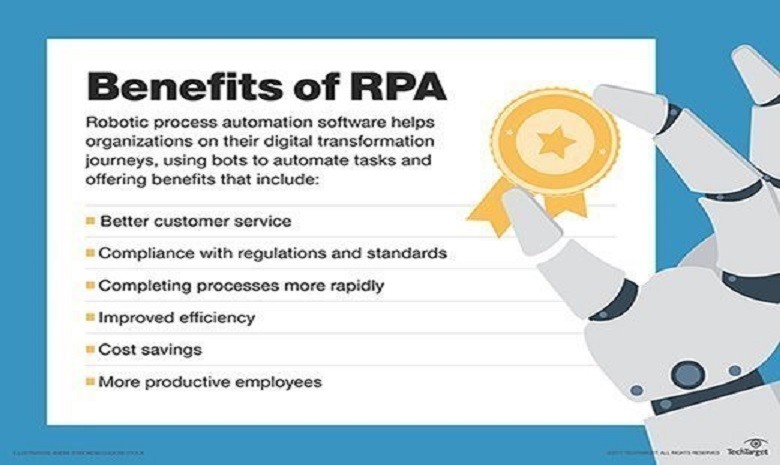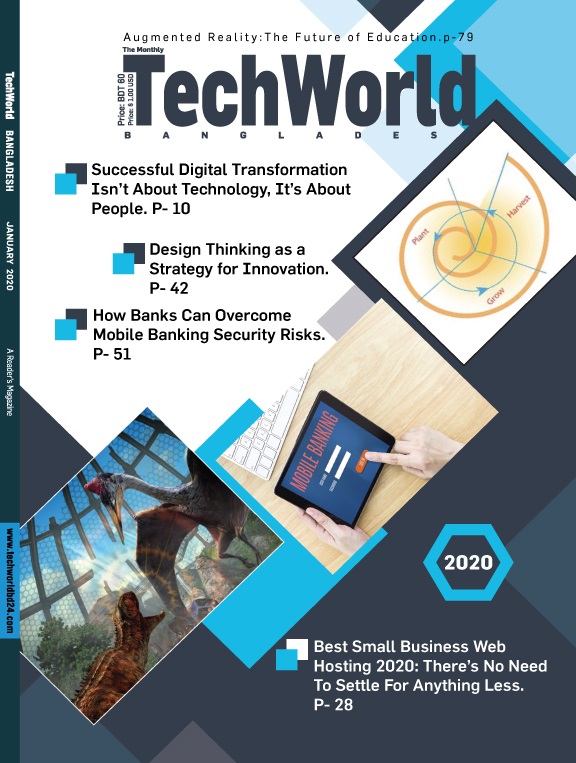Robotic process automation (RPA) is the use of software with artificial intelligence (AI) and machine learning capabilities to handle high-volume, repeatable tasks that previously required humans to perform. These tasks can include queries, calculations and maintenance of records and transactions.
Bottom of Form
Top of Form
Bottom of Form
RPA technology consists of software robots (bots) that can mimic a human worker. RPA bots can log into applications, enter data, calculate and complete tasks and then log out. Currently, practitioners divide RPA technologies into three broad categories: probots, knowbots and chatbots.

- Probots are bots that follow simple, repeatable rules to process data.
- Knowbots are bots that search the internet to gather and store user-specified information.
- Chatbots are virtual agents who can respond to customer queries in real time.
RPA software is not part of an organization's IT infrastructure. Instead, it sits on top of it, enabling a company to implement the technology quickly and efficiently -- all without changing the existing infrastructure and systems. What distinguishes RPA from traditional IT automation is the ability of the RPA software to be aware and adapt to changing circumstances, exceptions and new situations. Once RPA software has been trained to capture and interpret the actions of specific processes in existing software applications, it can then manipulate data, trigger responses, initiate new actions and communicate with other systems autonomously.
Benefits of RPA
Robotic process automation technology can help organizations on their digital transformation journeys by:
- Enabling better customer service.
- Ensuring business operations and processes comply with regulations and standards.
- Allowing processes to be completed much more rapidly.
- Providing improved efficiency by digitizing and auditing process data.
- Creating cost savings for manual and repetitive tasks.
- Enabling employees to be more productive.
Benefits of RPA
Applications of RPA
Some of the top applications of RPA include:
- Customer service: RPA can help companies offer better customer service by automating contact center tasks, including verifying e-signatures, uploading scanned documents and verifying information for automatic approvals or rejections.
- Accounting: Organizations can use RPA for general accounting, operational accounting, transactional reporting and budgeting.
- Financial services: Companies in the financial services industry can use RPA for foreign exchange payments, automating account openings and closings, managing audit requests and processing insurance claims.
- Healthcare: Medical organizations can use RPA for handling patient records, claims, customer support, account management, billing, reporting and analytics.
- Human resources: RPA can automate HR tasks, including onboarding and offboarding, updating employee information and timesheet submission processes.
- Supply chain management: RPA can be used for procurement, automating order processing and payments, monitoring inventory levels and tracking shipments.

The evolution of RPA
Although the term "robotic process automation" can be traced to the early 2000s, it had been developing for a number of years previously. RPA evolved from three key technologies: screen scraping, workflow automation and artificial intelligence. Screen scraping is the process of collecting screen display data from a legacy application so that the data can be displayed by a more modern user interface. The advantages of workflow automation software, which eliminates the need for manual data entry and increases order fulfillment rates, include increased speed, efficiency and accuracy. Lastly, artificial intelligence involves the ability of computer systems to perform tasks that normally require human intervention and intelligence.

Today, RPA software is particularly useful for organizations that have many different and complicated systems that need to interact together fluidly. For instance, if an electronic form from a human resource system is missing a zip code, traditional automation software would flag the form as having an exception and an employee would handle the exception by looking up the correct zip code and entering it on the form. Once the form is complete, the employee might send it on to payroll so the information can be entered into the organization's payroll system. With RPA technology, however, software that has the ability to adapt, self-learn and self-correct would handle the exception and interact with the payroll system without human assistance.
What to look for in RPA software
When enterprise leaders look for RPA technologies, they should consider a number of things, including:
- Scalability: Organizations shouldn't select RPA software that requires them to deploy software robots to desktops or virtualized environments. They should look for RPA platforms that can be centrally managed and scale massively.
- Speed: Enterprises should be able to design and test new robotic processes in a few hours or less, as well as optimize the bots to work quickly.
- Reliability: As companies launch robots to automate hundreds or even thousands of tasks, they should look for tools with built-in monitoring and analytics that enable them to monitor the health of their systems.
- Simplicity: Organizations should look for products that are simple enough that any employee in the business can build and use them to handle various kinds of work, including collecting data and turning content into information that enables leaders to make the best business decisions.
- Intelligence: The best RPA tools can support simple task-based activities, read and write to any data source, and take advantage of more advanced learning to further improve automation.
- Enterprise-class: Companies should look for tools that are built from the ground up for enterprise-grade scalability, reliability and manageability.
C-level decision-making around RPA
Though automation software is expected to replace up to 140 million full-time employees worldwide by 2025, many high-quality jobs will be created for those who maintain and improve RPA software.
When software robots do replace people in the enterprise, C-level executives need to be responsible for ensuring that business outcomes are achieved and new governance policies are met.
Robotic process automation technology also requires that the CTO/CIO take more of a leadership role and assume accountability for the business outcomes and the risks of deploying RPA tools.
Additionally, the COO, CIO and chief human resources officer, as well as the relevant C-level executive who owns the process being automated, should all work toward ensuring the availability of an enterprise-grade, secure platform for controlling and operating bots across systems.
Where the robotic process automation market is heading
A Global Market Insights Inc. report expects the RPA market to reach $5 billion by 2024. The increased adoption of RPA technologies by organizations to enhance their capabilities and performance and boost cost savings will reportedly drive the growth of the robotic process automation market most during that time.
8 keys to a successful RPA implementation
Robotic process automation can reap efficiencies and free up staff time for higher-value tasks. Here’s how to do RPA right.

Thinkstock
Robotic process automation (RPA) is gaining traction at a variety of organizations, thanks to its promise to offload time-consuming, mundane tasks to “software robots” that can perform them faster and in many cases more accurately than humans can. This strategy for streamlining operations offers the added benefit of freeing up staff time to tackle higher-value efforts — an important advantage for organizations undertaking digital transformations.
But RPA implementations are challenging, with no guarantee of success. In fact, if not done properly, a shift to RPA might end up creating more problems than companies bargained for.
[ Find out why RPA is poised for a big business breakout and why RPA implementations fail. | Get all your RPA questions answers with our robotic process automation explainer. | Get the latest insights by signing up for our CIO daily newsletter. ]
One of the most common reasons why RPA implementations fail is the existence of politics and protectionism within organizations, says Frank Casale, founder of the Institute for Robotic Process Automation & Artificial Intelligence (IRPA AI), an independent professional association for buyers, sellers, influencers and analysts within the RPA market.
“This is after all a disruptive technology, and most managers don't want their department and/or team to be disrupted,” Casale says. Other common reasons for failure include poor planning, poor use case selection, or deploying the wrong RPA technology to meet the organization’s needs, he says.
Here are some suggested best practices for a successful RPA deployment.
Do the research
RPA is a relatively new technology and market, and the vendor landscape, product offerings and features have shifted in recent years. Before plunging ahead with a deployment, do your homework and invest the time to build a business case for RPA and learn about the products available, Casale says.
“Realize that you will need to check three key boxes to get to success, and two out of three won't cut it,” Casale says. These three boxes include: choosing the right technology solution to meet your organization’s specific needs; creating a solid business case for RPA, including developing return on investment (ROI) metrics; and assessing current processes and organizational issues to avoid political problems.
Because RPA is new and internal expertise is likely limited, it might make sense to seek help from an expert adviser when developing a strategy, selecting a vendor, and deploying and maintaining RPA solutions.
“RPA programs require transformation,” says Tony Abel, managing director at consulting firm Protiviti. “Transformation from within is challenging, given current media attention around robotics, cognitive computing, and other AI-spectrum technologies. These technologies will de-skill a sizable portion of existing enterprise organizations as we know them, and those human resources are not eager to train the robots that might replace them.”
Experts can help navigate this challenge by creating a vision for the future and a roadmap to get there that includes creating new opportunities for displaced workers, Abel says.
Educate staffers about RPA
Because it’s a disruptive technology, RPA can cause a lot of angst among workers. For that reason, it’s important to clarify what the technology will and will not do with regard to employees’ job roles.
“Educate everyone in the organization about benefits of RPA and the approach your organization is taking,” says Janesh Patel, vice president of hotel technology at the Wyndham Hotel Group, the world’s largest hotel company.
“There is lot of commotion about job loss in the industry,” Patel says. “For us, RPA is strategic in helping our technical services staff perform routine tasks quickly and efficiently, so they can spend time in engaging with our franchisees and guests addressing higher priority needs.”

Wyndham opens two new hotels per day every day of the year, and a priority is to bring those hotels onto its property management and central reservations systems as quickly as possible. The volume of new hoteliers joining the system is a challenge due to the time needed for hotel data services on new franchisees to be entered into the platforms and with other onboarding tasks.
“Since our volume fluctuates throughout the year with onboarding new properties, we had to leverage automated solutions to reduce resource constraints in meeting our business demands, reduce up-front costs for our franchisees, and reduce volume for our property technology help desk,” Patel says. In 2014 the company deployed an RPA system from Kryon to automate these functions, and was able to reduce franchisees’ upfront costs, decrease help desk volume, and provide better onboarding experiences for its new franchisees.
Determine where the technology will work best
When deploying RPA tools, it’s best to identify processes where you’re most likely to see a positive business impact. Doing so, will greatly increase your likelihood of success in modernizing your business processes. But keep in mind that figuring out the best RPA targets might not be easy.
“Building your initial pipeline and coming up with a plan to prioritize the highest value processes to automate is a challenge,” Patel says. “As the process automation journey matures, be ready to refine the process.”
To improve its RPA processes, Wyndham leveraged process discovery products — basically, bots to define where bots can work — to accelerate its implementation and to validate which processes would have the highest returns with RPA.
Financial services provider FBMC Benefits Management deployed RPA to help automate the process of extracting data from systems in order to create reports for insurance carriers, which was taking up 60 percent of the workday for some employees.
The firm was highly selective about where to apply the technology, which is now extracting, running, and validating reports with 99 percent accuracy. RPA “runs in the middle of the night, extracts relevant information from our proprietary system, and generates a file [that’s] ready to be sent securely to a carrier,” says Sajed Khan, COO at FBMC. The technology allowed the firm to shift workers to more sophisticated roles within the technology department.
“Great candidates for [RPA] are those tasks that are repetitive and frequent,” Khan says. “It’s easy after having a successful RPA deployment to assume that everything can and should be automated. Our experience has shown that successful automation is when there is little to no human interaction in the automation sequence. Processes that don’t exhibit this trait aren’t seen as viable candidates for automation.”
Keep it simple and modular
RPA doesn’t have to be complex. “Build bots as common and reusable objects,” says Mona Kahn, director of securitization and servicing technology at Fannie Mae, a U.S. government-sponsored provider of mortgage-backed securities.
“When we build out a process, we try to build as many generic components as possible and externalize all variables and logic to minimize the failure points, make it much easier to update if and when something does change, and much faster and easier to test before deploying to production,” Kahn says.
Fannie Mae began its RPA journey in late 2016 with a small proof of concept, and deployed the first RPA bot to production in March 2017. The driver behind implementing RPA was to decrease risks by automating manual and error-prone work, generate efficiencies by simplifying and automating processes at scale, and creating capacity for staff to work on more valuable activities.
“All of these ultimately lead to becoming a smarter workforce and improving our customers’ experience,” Kahn says. The organization is using an RPA tool from Blue Prism.
Don’t neglect data security
Companies can get so caught up in the rush to automate processes that they don’t take security into consideration.
“Service security is very important, as transactions are processed with incredible speed,” says Andrea Martschink, head of robotics strategy, business development and projects at the IT Enterprise Content Management Department of conglomerate Siemens AG.
“It must be ensured that processes cannot be manipulated,” Martschink says. “The more critical the respective business process is, the more attention and efforts need to be made with respect to stable and secure execution.”
Siemens launched a “professional RPA service” in October 2017, which is now available worldwide within Siemens. The platform allows for structured and unstructured information such as text, speech, files and email to trigger an RPA bot, which is used to automate various tasks. The main benefits the company is seeing are cost reduction, quality improvement, and faster response times, Martschink says.

Test implementations regularly
RPA work is not done once systems have been deployed. Companies need to test these automation tools on a regular basis to find and address any weaknesses.
Insurance company Unum Group began using RPA in 2016 when it deployed Pega Robotic Desktop Automation (RDA) from Pegasystems to help its contact center automate various administrative tasks.
Unum’s customer service representatives previously had to log into several different systems for simple tasks such as changing a customer’s address, then copying and pasting information in other secure fields. The system captures data from various legacy systems to help with changing addresses.
“With an increased focus on improving our customer experience, we needed a solution that eliminated these administrative tasks and gave the customer service agent more time to focus on the customer’s claim,” says Rex Price, technology capability manager of Shared Services at Unum Group.
Unum relies on its business users to help with user acceptance testing of RPA. “Individuals testing who may not do this sort of work on a regular basis can sometimes only check for positive tests,” Price says. “Therefore, it's essential to have a robust test strategy ensuring that both positive and negative tests are completed.”
It’s also important to conduct performance testing on desktop automations using legacy systems, to ensure the desktop can handle the additional infrastructure requirements of the automation, Price says.
Develop a cross-functional center of excellence
As the use of RPA expands through an organization, it might make sense to create a center of excellence to share experiences and best practices.
Engineering, procurement, and construction company Bechtel began its foray into RPA in 2016 by conducting a proof of concept in Bechtel Business Services, an organization that provides a variety of shared services to Bechtel, including finance and accounting, payroll, and corporate systems.
The proof of concept involved automating the human resources management system (HRMS) input audit process, which included matching HRMS changes with supporting documentation to identify non-compliant input, according to Trish Wildfang, manager of corporate systems at Bechtel.
Following the success of the POC and pilot processes in finance and human resources, the company in 2017 established an RPA Center of Excellence as a shared service for all Bechtel business units and functions.
“Our Center of Excellence consists of developers based in IT, as well as in shared services functions such as HR and Finance,” Wildfang says. “This allows the team to leverage both technical and functional expertise. The team also consists of part-time developers who are brought in full time whenever demand increases.”
Since establishing the center, “we have deployed nearly 40 bots within various Bechtel departments and business units,” Wildfang says. “So far, increased productivity is one of the tangible, and most encouraging, results we have seen from the implementation of RPA bots. By shifting routine and transactional activities to our ‘virtual workforce,’ we free our colleagues to focus entirely on complex, judgment-based, and value-added processes for our customers.”
Prepare for future advances and challenges
RPA is continuing to advance and it’s important to keep up with the changes. “As RPA adoption increases and more human labor is digitized into organizational capital, RPA technologies will provide more advanced cognitive capabilities and/or integrate further with cognitive capabilities,” Protiviti’s Abel says.
The technology will likely evolve to include self-building robots, verbal controls and interactions, and course corrections based on advanced learning capabilities, to handle a greater number of exceptions and more nuances in processing, Abel says.
“Process automation will be used so expansively that organizations will eventually struggle with the management of automation,” Abel says. Those old enough to remember a time without mobile phones “never worried about how to manage the amount of data that would be used by our families, or which of the hundreds of service plans was best for us, or whether an iPhone, Google phone or some other device was best suited for our use,” he says.
RPA will be much the same, although with significantly more complexities. “How do we track, manage, and maintain all of the production bots running throughout the enterprise?” Abel says. “What about the desktop automation every employee has developed independently for his/her individual use? How will the introduction or elimination of enterprise applications impact the thousands of bots that have been developed and deployed across the existing technology landscape
Total views: 11220



























